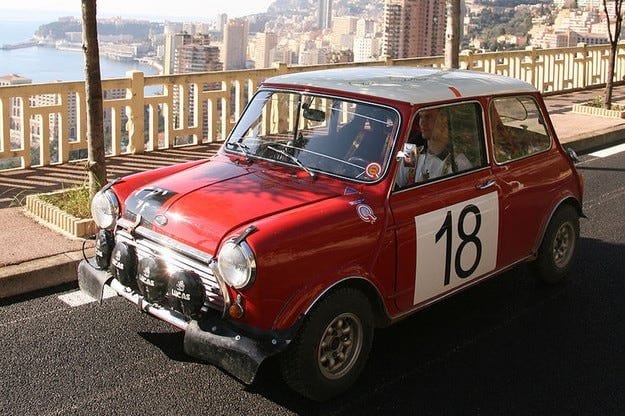
Test Drive Mini Cooper S Rallye: Baby Call

With a reproduction of Rauno Altonen's car on the Monte Carlo rally track.
In 1959, the first Mini rolled off the assembly line. Five years later, the little Briton dominated the legendary Monte Carlo Rally for the first time. Today we are looking for traces of a former rally hero in the French Alps-Maritimes.
V-shaped eight versus a 4,7-liter inline-four with 285 hp. against the ridiculous 1071 cubic meters. centimeter and 92 hp. Despite the eloquent initial balance of power, the main motive in comments about the 1964 Monte Carlo Rally was “David defeated Goliath”. While the Beatles attack the top of the music world on their first world tour, Mini turns ideas and concepts in international rally sports upside down. 52 years ago, the British driver won the famous Monte.
Mini - Monte Carlo Winner
We follow in the footsteps of the legendary mini-winner with a replica of the 1968 factory driver Rauno Altonen's rally. At a leisurely city pace, the car, with start number 18 and a roaring racing exhaust muffler, drives between high-end fashion boutiques and full bistros, exploring legendary turns on the small principality's Formula 1 circuit.
Rascas, Lewis, The Pool – Unlike the modern Monte Carlo Rally, between 1951 and 1964 the drivers not only drove through the mountain passes in the French Alpes-Maritimes, but also completed the high-speed section at the end of the rally. on the race track in Monaco.
Along with the fast pace of the times, the handicap rule of the day, which took away the benefits of high-volume cars, gave a decisive advantage to the British Motor Corporation (BMC) factory team from Oxford near Abingdon. After five laps, the 1964 sensation was complete - Paddy Hopkirk and his co-driver Henry Lyden scored their Mini 30,5 points ahead of Swedish favorites Bo Jungfelt and Fergus Sager in a much more powerful engine. Ford Falcon.
“Compared to the mountain roads, the Formula 1 circuit at Monte was child's play for us drivers; we had good visibility here and the road was much wider,” Altonen recalls with a somewhat despondent air. With eight final victories in various international rallies, the famous driver is still the most successful Mini factory driver. In 1967, the Finn won the right to park a nice car, decorated in the company's typical fiery red dress (red tartan and white roof), in front of the prince's box near the palace in Monte Carlo, to receive the coveted Monte Carlo winner's trophy. ".
Mini has shown significant advantages in traction
The success of the British Dwarf Rally is based on a simple recipe. “The power of the Mini was not surprising. The small, nimble, front-wheel-drive cars simply had an advantage in snow grip,” explains Peter Falk, former head of the company's racing department. Porsche and co-driver in the 1965 Monte Carlo Rally. Together with then-Porsche driver Herbert Linge, the Falk achieved a convincing fifth overall in the first-ever sporty performance of the 911 Falk.
Even the creak of spiked tires on the tiny ten-inch Minilite wheels shows that the pavement is dry today. Even if we expected an extreme road situation with dangerous icing and trampled snow cover, like in 1965, we simply did not know. While the retro replica with its direct steering system spins nimbly through the tight bends of the Turin Pass, we can only guess how much stress and fatigue the former pilots have been subjected to.
To this day, the 1965 race is considered the toughest in the history of the Monte Carlo Rally. Then the program included only about 4600 kilometers. Of the 237 participants, only 22 were able to reach the final in Monaco during a blizzard that raged in the French Jura region. “Compared to those years, today's rallies are like children's entertainment because they are very short,” said former European rally champion Altonen.
In 1965, participants started from Warsaw, Stockholm, Minsk and London to Monaco. On the front is a BMC Cooper S with race number 52 and black and white AJB 44B markings on a short front cover secured only by thick leather straps.
Heated windshield for winter rally
Timo Makinen and co-driver Paul Easter dominated the six nighttime stages, with their 610kg rally car flying five times, setting the fastest time in the intermediate finals. Small but important details help them to maintain good visibility even on ice and snow – especially for participation in Monte Carlo, the BMC racing department designs a heated windshield.
Three times the night chase passes through the heart of the "Monte" - the route of the Col de Turini. On the most difficult section, pilots will have to climb from the sleeping mountain village of Moulin through the plateau of the pass with a height of 1607 meters to the end of the section in the village of La Bolin-Vesubie. Countless sharp turns, dizzying tunnels; on the one hand, an uneven wall of rocks, on the other, a gaping abyss with deep abysses - all this has always been a part of Monte's daily life. In fact, it doesn't matter if the depth of the abyss is 10, 20 or 50 meters, or if you hit a tree - if you think about these things, you should not take part in the rally, at least in Monte - Altonen explains the experience of a risky raid through the Maritime Alps.
Knee-high retaining walls in front of deep chasms inspire respect and cause today's seeker of past sporting glory to accidentally rip his foot off the accelerator pedal. Shortly thereafter, the highest point of the passage finally appears in front of Mini's short snout. Is this an abandoned parking lot no bigger than a handball court, the most famous section of the Monte Carlo Rally?
Unusual mood on the Turin plateau
As if infinitely far from the excitement during the races, a plateau with a height of 1607 meters plunged into contemplative peace. Lone passengers drive past a racing Mini and dive into one of Turin's four restaurants, while lone cyclists pant at ride height, otherwise deceptive silence reigns around.
And once, especially during the Monte Carlo Rally in the 60s, tens of thousands of spectators crowded here, tightly lined up behind bars. Powerful searchlights and blinking flashes of photographers turned the parking lot into the epicenter of a nightly rally. “At first everything was black on the high-speed section, then suddenly, obliquely over the hill, you took off to the Turin plateau, where it is bright as day. In order not to be dazzled, we always lowered the Mini flashlight,” recalls Monte winner Altonen, ready today to fall into the unusual mood of those days.
However, Timo Makinen was very diligent in keeping the good mood in the Mini factory team. “Makinen was a prankster, once he was climbing his Mini on the ski slope, behind the houses,” Madeleine Manizia, a cook at the Yeti restaurant on the plateau, recalls as she looks at our retro Mini in amazement. “When he came here, Timo always ate beef and fries and drank a lot of whiskey in the car. Then a good mood was guaranteed,” shares her husband Jacques, former owner of a dark green Mini Cooper S, with a big smile.
Thus ends the journey in the footsteps of the characters of Monte Carlo - with beef and French fries. No whiskey in the car, because the current source of good mood at number 18 awaits us, looking forward to another quick descent through the Turin Pass.
Text: Christian Gebhart
Photo: Reinhard Schmid
INFORMATION
Col de Turini
Thanks to the Monte Carlo Rally, the Col de Turini has become one of the most famous passes in the Maritime Alps. If you want to follow the tracks of the rally route, you need to go to the pass from the south through the village of Muline (827 m above sea level). After crossing a plateau with a height of 1607 meters, the initial route follows the D 70 road to La Bolene-Vesuby (720 m). If the road is closed, the Col de Turini can also be reached via the D 2566 from Peyra Cava.

